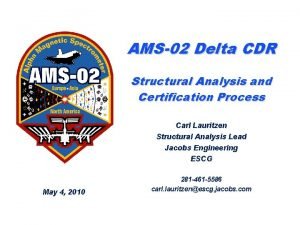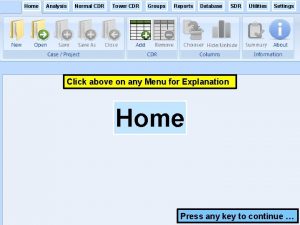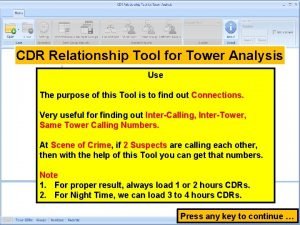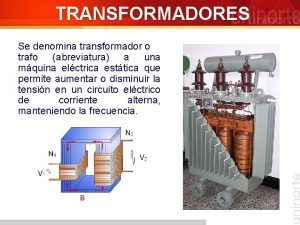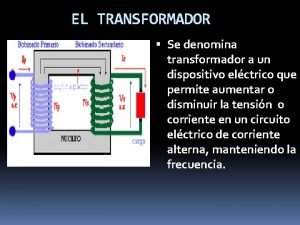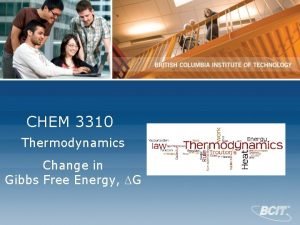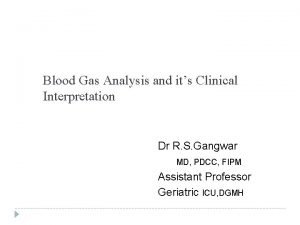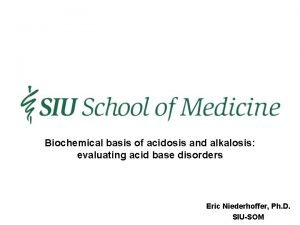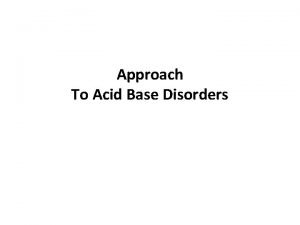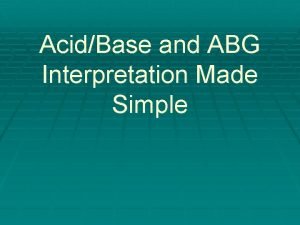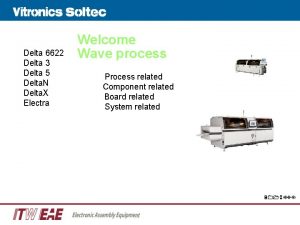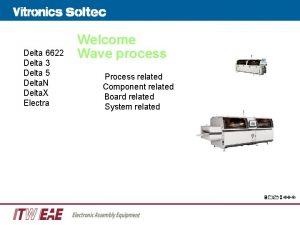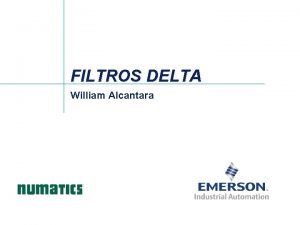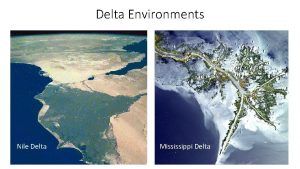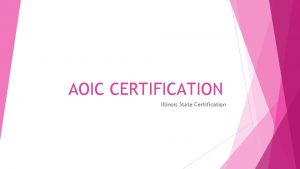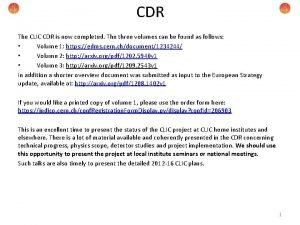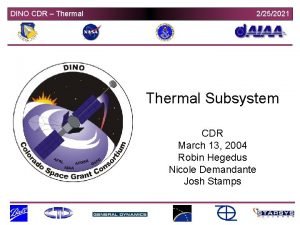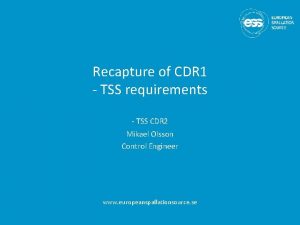AMS02 Delta CDR Structural Analysis and Certification Process











- Slides: 11

AMS-02 Delta CDR Structural Analysis and Certification Process Carl Lauritzen Structural Analysis Lead Jacobs Engineering ESCG May 4, 2010 281 -461 -5586 carl. lauritzen@escg. jacobs. com

Structural Verification Plan • The requirements and certification plans specified in the current AMS-02 SVP (JSC-28792, Rev. F) are still applicable to the existing hardware. • The requirements in the current SVP will apply to the new hardware for the following items: – Fastener integrity --- procurement and lot testing – Preloaded bolts --- torque determination and installation procedures (per MSFCSTD-486 B), structural assessment (per NSTS 08307) – Material usage will be verified in accordance with all applicable requirements. • None of the materials for the new hardware requires a Material Usage Agreement. • There are no structural welds currently planned for the new hardware. – Fracture control and fatigue requirements will be satisfied. • Changes to the existing SVP for the new hardware discussed on subsequent charts. – We will seek written concurrence/approval from the NASA ES Structures Working Group and the NASA OB ISS Structures Team for all deviations from the existing SVP. Carl Lauritzen/ESCG AMS-02 Delta CDR --- May 4, 2010 2

Overview of Structural Impacts • Change from cryogenic magnet to permanent magnet simplifies the structural analysis – – – • The major structural changes are confined to the vacuum case – – • • • Structural nonlinearities associated with previous support straps are gone, so entire payload can be assessed as a linear system which greatly simplifies analyses and decreases uncertainty. The vacuum case is no longer an evacuated system, so there are no buckling issues for the vacuum case. Removal of the liquid helium tank eliminates slosh issues. Stiffness lost by removing the inner cylinder is compensated by attaching the conical flanges to the magnet structure. Support struts maintain the same line of action as the previous magnet support straps so that the load path through the vacuum case rings is not significantly altered. New hardware is being designed with increased factors of safety and robust structural margins to facilitate structural certification by analysis only. Permanent magnet was previously certified for flight. Addition of the upper tracker plane does not have any significant structural impacts. Addition of the lower tracker plane requires the ECAL to be lowered. Payload weight and fundamental frequencies are not significantly changed. – – – Overall the payload is stiffer, so the fundamental frequencies will increase slightly. Interface forces between Orbiter/AMS-02 and ISS/AMS-02 are not expected to increase. Payload dynamics on SRMS and SSRMS should not be significantly affected. Carl Lauritzen/ESCG AMS-02 Delta CDR --- May 4, 2010 3

Design Loads and Factors of Safety • Load factors for design of the new hardware were based on component interface forces from the 2 nd DCLA of the existing payload (as documented in the SVP). • Factors of Safety have been increased for new hardware Existing, Tested Existing, Untested New, Untested Yield 1. 1 1. 25 2. 0 Ultimate 1. 4 2. 0 3. 0 • Loads for detailed structural assessment of the new hardware and the existing hardware will be determined from an upcoming DCLA. • Final assessment of the full payload will be performed using loads from the VLA for the designated flight and associated manifest. Carl Lauritzen/ESCG AMS-02 Delta CDR --- May 4, 2010 4

Frequency Verification • The structural modes for the new hardware will be verified by analysis. – Preliminary modal analysis of the permanent magnet and associated support structure integrated with the vacuum case shows the frequency of the 1 st mode is 73. 4 Hz. – Preliminary modal analysis of the upper tracker plane shows the frequency of the 1 st mode is 60. 5 Hz. – Preliminary modal analysis of the lower tracker plane shows the frequency of the 1 st mode is 61. 2 Hz. – Further assessments with more detailed and finalized models will be used to confirm that the fundamental frequencies of these hardware remain greater than 50 Hz. • Structural modes of the full payload will be verified using data from the completed modal test of the existing hardware in combination with analysis that incorporates the new hardware. – Since the weight of the full payload with the new hardware is essentially unchanged and the Unique Support Structure (USS) is unchanged, the fundamental modes of the payload are not expected to change significantly. – The modes previously associated with motion of the cryogenic magnet inside the VC are no longer present. Carl Lauritzen/ESCG AMS-02 Delta CDR --- May 4, 2010 5

Strength Verification • Since the total payload weight is not changed and the Unique Support Structure is not changed, the results from the static test of the existing hardware still valid. • The permanent magnet was certified and flown on STS-91 – The hardware was tested to 17. 7 g’s in a centrifuge. – The hardware was vibration tested to qualification levels. – A dedicated test article (without glue to hold magnet blocks in place) was tested to loads > 3 times the predicted ultimate loads. The structure yielded but did not fail. – Bolts that attach magnet flanges to core structure have been replaced with new bolts. • Strength verification of the new hardware will be by analysis using increased factors of safety (FSyld = 2. 0 and FSult = 3. 0) Carl Lauritzen/ESCG AMS-02 Delta CDR --- May 4, 2010 6

Loads Analysis • The full AMS-02 payload with the new hardware will be assessed for flight loads using the standard process for Shuttle payloads – Preliminary design of the new hardware is based on load factors from a DCLA for the full payload with the existing hardware. – Finite element models for the new hardware have been generated and integrated into the finite element model of the full payload. – The finite element model of the permanent magnet started with the same model used in the test-correlated model of the full STS-91 payload. It was updated to reflect the new bolted connections to the VC. – A DCLA using the updated math model of the AMS-02 payload will performed using the STS models and forcing functions for the existing STS-134 manifest. – Updated load factors will be developed using the transient data from the DCLA • A detailed structural assessment will be performed for the new hardware. • If the new load factors are larger than existing design loads, the existing structure will be reassessed for structural strength. • Loads for final certification of the payload will be based on VLA results – The math model for the VLA will use the existing test-correlated math model with updates to account for the hardware modifications. Carl Lauritzen/ESCG AMS-02 Delta CDR --- May 4, 2010 7

Preliminary Strength Assessment of Magnet Support Struts Maximum strut load = 4991. lb MS = 11. 9 for bar MS = 2. 0 for strut buckling MS = 0. 34 for rod-end bearing For rod-end bearing, a load of 17500 lb is required to reduce margin to zero (computation is not linear). Carl Lauritzen/ESCG AMS-02 Delta CDR --- May 4, 2010 8

Preliminary Strength Assessment of X-Structure Frame Margins of Safety MSu = 1. 7 MSy = 2. 3 Carl Lauritzen/ESCG AMS-02 Delta CDR --- May 4, 2010 9

Preliminary Strength Assessment of X-Structure Strut Clevis Margins of Safety MSu = 0. 3 MSy = 0. 6 Carl Lauritzen/ESCG AMS-02 Delta CDR --- May 4, 2010 10

Preliminary Strength Assessment of Modified Vacuum Case The peak stress occurs at the edge of the through-hole in the pocket. The peak stress is ~10. ksi. For FSult = 3, MSult = 0. 75 Carl Lauritzen/ESCG AMS-02 Delta CDR --- May 4, 2010 11
